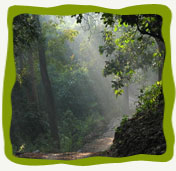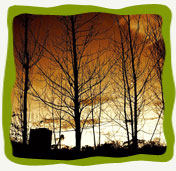Climate of Corbett National Park
 Summer Temperature: 20o C to 40o C
Summer Temperature: 20o C to 40o C
Winter Temperature: 5o C to 30o C
Best Time to Visit: November to June
Located between 29°25' to 29°39'N latitude and 78°44' to 79°07'E longitude, Corbett National Park nestled amidst several minor streams, ravines and small plateaus experiences temperate climate. It enjoys three different seasons- summer, monsoon and winter along with climatic variations. Tourists can enjoy the rare experience of being with animals between November and June, the best time as the park remains open for the visitors. It is recommended not visit it during monsoons as heavy downpours wash away the roads.
Summer
The summer season begins from March and continues till mid-June. The days are characterized by extreme dry heat with temperature shooting upto 40°C and sometimes even more than that while the evenings are marked by occasional thunderstorm and rains, a welcome respite for the dwellers. The blazing summer heat makes it unbearable for the residents of the park.
Monsoon
 The monsoons usually arrive in mid-June and lasts upto October. The rain showers brings immense relief from the oppressive heat of the summers. This period is also prone to land slides and soil erosion, hence not reccommended for jungle adventure. Since it is the mating period of most of the animals therefore the park remains closed for the tourists. The monsoon season is also marked by a greater rise in humidity reaching upto 98% which makes the weather extremely hot and moist.
The monsoons usually arrive in mid-June and lasts upto October. The rain showers brings immense relief from the oppressive heat of the summers. This period is also prone to land slides and soil erosion, hence not reccommended for jungle adventure. Since it is the mating period of most of the animals therefore the park remains closed for the tourists. The monsoon season is also marked by a greater rise in humidity reaching upto 98% which makes the weather extremely hot and moist.
Winter
Winter begins from November and lasts through February. It is the best time to explore the hidden treasures of the park. This period is marked by heavy influx of tourists. The weather is extremely soothing during this time of the year. The humidity level also drops down to about 57%. One can spot animals in large numbers as they move about freely .The days are pleasant while the nights are chilly. The temperature at night dips to 5° C. as the local wind known as 'dadu' that blows during the night brings down the temperature to a greater extent

Search Hotels
Corbett Hotels
- Vanghat River Lodge Corbett
- Camp Forktail Creek
- Camp Kyari Corbett
- Hotel Tiger Camp Corbett
- Hotel Corbett Kingdom
- The Den Resort Corbett
- Jungle Paradise Retreat
- Corbett Heaven Resort
- Ashoka's Tiger Trial
- Corbett Treff Hotel
- Suman Grand Resort Corbett
- La Perle Resort Corbett
- Corbett Bijrani Jungle Camp
- Corbett Ramganga Resort
- Corbett Roop Resort
- Corbett Tiger Den Resort
- Dhikala Forest Lodge
- Infinity Resort Corbett
- Quality Inn Corbett Resort
- Wild Crest Resort Corbett
- Tarikas Jungal Retreat
- Tarangi Resort Corbett
- Nirvana Corbett
- Corbett River Wild Resort
- Country Inn Corbett
- The Solluna Resort Corbett
- Call of the Wild Resort
- Wood Castle Spa and Resort
- Jim's Jungle Retreat Corbett
- Corbett Jungle Club Resort
- Jungle Brook Camp Resort
- Corbett Leela Vilas
- Kamya Resort Corbett